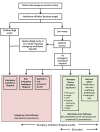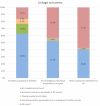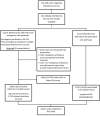Appropriateness of cases presenting in the emergency department following ambulance service secondary telephone triage: a retrospective cohort study
- PMID: 29038180
- PMCID: PMC5652623
- DOI: 10.1136/bmjopen-2017-016845
Appropriateness of cases presenting in the emergency department following ambulance service secondary telephone triage: a retrospective cohort study
Abstract
Objective: To investigate the appropriateness of cases presenting to the emergency department (ED) following ambulance-based secondary telephone triage.
Design: A pragmatic retrospective cohort analysis of all the planned and unplanned ED presentations within 48 hours of a secondary telephone triage.
Setting: The secondary telephone triage service, called the Referral Service, and the hospitals were located in metropolitan Melbourne, Australia and operated 24 hours a day, servicing 4.25 million people. The Referral Service provides an in-depth secondary triage of cases classified as low acuity when calling the Australian emergency telephone number.
Population: Cases triaged by the Referral Service between September 2009 and June 2012 were linked to ED and hospital admission records (N=44,523). Planned ED presentations were cases referred to the ED following the secondary triage, unplanned ED presentations were cases that presented despite being referred to alternative care pathways.
Main outcome measures: Appropriateness was measured using an ED suitability definition and hospital admission rates. These were compared with mean population data which consisted of all of the ED presentations for the state (termed the 'average Victorian ED presentation').
Results: Planned ED presentations were more likely to be ED suitable than unplanned ED presentations (OR 1.62; 95% CI 1.5 to 1.7; p<0.001) and the average Victorian ED presentation (OR 1.85; 95% CI 1.01 to 3.4; p=0.046). They were also more likely to be admitted to the hospital than the unplanned ED presentation (OR 1.5; 95% CI 1.4 to 1.6; p<0.001) and the average Victorian ED presentation (OR 2.3, 95% CI 2.24 to 2.33; p<0.001). Just under 15% of cases diverted away from the emergency care pathways presented in the ED (unplanned ED attendances), and 9.5% of all the alternative care pathway cases were classified as ED suitable and 6.5% were admitted to hospital.
Conclusions: Secondary telephone triage was able to appropriately identify many ED suitable cases, and while most cases referred to alternative care pathways did not present in the ED. Further research is required to establish that these were not inappropriately triaged away from the emergency care pathways.
Keywords: health services misuse; health services needs and demand; referral and consultation; telephone; triage.
© Article author(s) (or their employer(s) unless otherwise stated in the text of the article) 2017. All rights reserved. No commercial use is permitted unless otherwise expressly granted.
Conflict of interest statement
Competing interests: KE is an intensive care paramedic and has previously worked as a call-taker with the Ambulance Victoria Referral Service (secondary telephone triage service). JE was the Chair of the Board of Ambulance Victoria. KS is the Manager of Research and Evaluation for Ambulance Victoria. AM has no competing interests.
Figures



References
MeSH terms
LinkOut - more resources
Full Text Sources
Other Literature Sources
